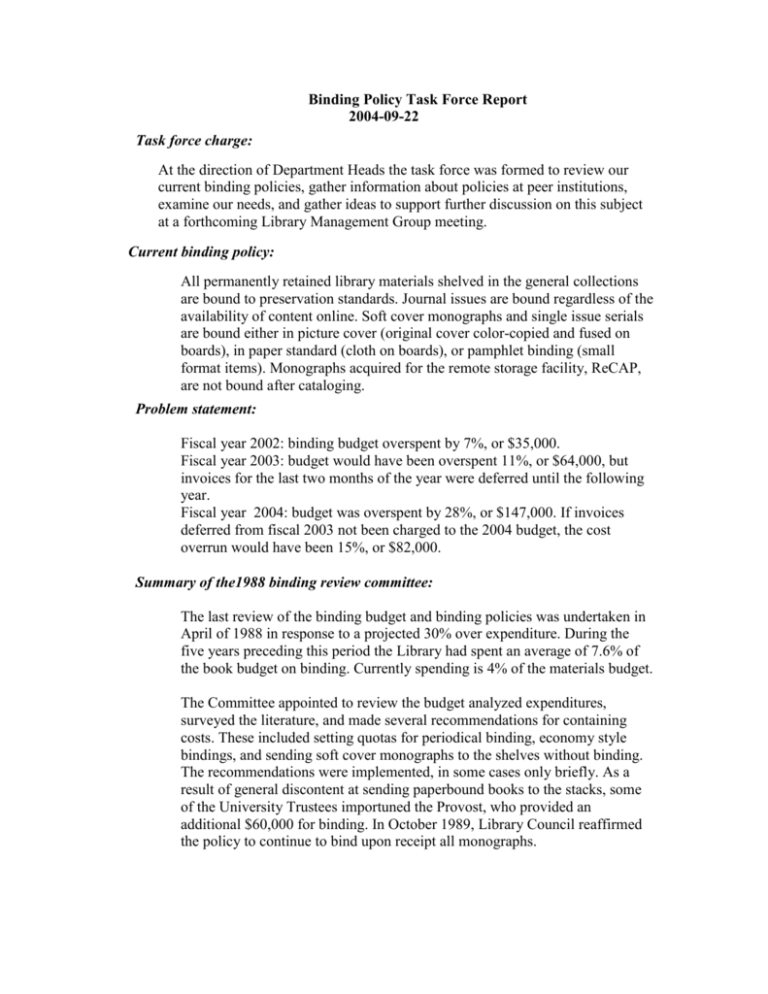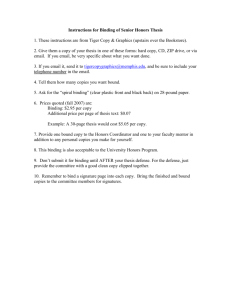Binding Policy Task Force Report
advertisement

Binding Policy Task Force Report 2004-09-22 Task force charge: At the direction of Department Heads the task force was formed to review our current binding policies, gather information about policies at peer institutions, examine our needs, and gather ideas to support further discussion on this subject at a forthcoming Library Management Group meeting. Current binding policy: All permanently retained library materials shelved in the general collections are bound to preservation standards. Journal issues are bound regardless of the availability of content online. Soft cover monographs and single issue serials are bound either in picture cover (original cover color-copied and fused on boards), in paper standard (cloth on boards), or pamphlet binding (small format items). Monographs acquired for the remote storage facility, ReCAP, are not bound after cataloging. Problem statement: Fiscal year 2002: binding budget overspent by 7%, or $35,000. Fiscal year 2003: budget would have been overspent 11%, or $64,000, but invoices for the last two months of the year were deferred until the following year. Fiscal year 2004: budget was overspent by 28%, or $147,000. If invoices deferred from fiscal 2003 not been charged to the 2004 budget, the cost overrun would have been 15%, or $82,000. Summary of the1988 binding review committee: The last review of the binding budget and binding policies was undertaken in April of 1988 in response to a projected 30% over expenditure. During the five years preceding this period the Library had spent an average of 7.6% of the book budget on binding. Currently spending is 4% of the materials budget. The Committee appointed to review the budget analyzed expenditures, surveyed the literature, and made several recommendations for containing costs. These included setting quotas for periodical binding, economy style bindings, and sending soft cover monographs to the shelves without binding. The recommendations were implemented, in some cases only briefly. As a result of general discontent at sending paperbound books to the stacks, some of the University Trustees importuned the Provost, who provided an additional $60,000 for binding. In October 1989, Library Council reaffirmed the policy to continue to bind upon receipt all monographs. The following chart provides an overview of binding volume for the past eight years. BINDING OVERVIEW 90000 80000 PICTURE COVER monographs 70000 PAPER STANDARDS monographs Amount of binding Single Issue Serials 60000 PAMPHLET monographs 50000 REBINDS 40000 PERIODICAL STANDARDS 30000 PERIODICAL- ECONOMYS 20000 GEST serials 10000 TOTAL BINDING PER YEAR 2003/04 2002/2003 2001/2002 2000/01 1999/00 1998/99 1997/98 1996/97 0 Years Summary of current literature: A review of selected literature on the subject of binding library acquisitions shows that libraries throughout North America grapple with the cost of commercial binding and seek ways to rationalize the expenditure of, on average, 3-4% of the materials budget on binding. Or, conversely, they seek to rationalize a decision to reduce or eliminate some or all categories of commercial binding as a means of protecting their collections. Much of the available literature focuses on the question of whether or not to continue to bind journals that are also available electronically. The most inventive of these articles was one on shrink-wrapping journal issues as a substitute for binding them. The literature in general is scant and not focused on the needs of a research collection. Summary of a survey of peer institutions: An informal survey on binding policies was sent to the ALCTS Discussion Group Heads of Technical Services of Large Research Libraries. Thirteen of the 26 libraries responded. These included Columbia University, Indiana University, University of Texas-Austin, New York University, Library of Congress, University of Wisonsin-Madison, Ohio State University, University of Washington, University of Chicago, Stanford University New York Public Library, University of North Carolina-Chapel Hill, and Duke University. Libraries in this group spend on average about 4% of their materials budget on binding. In response to the question on binding soft cover monographs, only one library has a policy of binding all permanently retained materials. Seven libraries bind based on the physical characteristics of the material, with some soft cover materials bound at time of cataloging and some sent to the shelves without binding. The other responses varied from no binding to binding after some number of circulations. Of those libraries which choose not to bind automatically, four noted that the policy was too new to allow assessment of impact on the well-being of the collection. Eight respondents have had this policy in place for more than three years and report a range of experiences from deterioration of the collection to little or no impact. Those libraries that have actually sampled the collection to assess condition have found that the impact of not binding on the collection has been manageable, although “manageable” was not defined. Without exception, respondents do bind periodical issues whether or not the issues are also available online. Several cited the uncertainty of persistent archiving as a concern, one noted the variation in content between print and online. One library set quotas by collection for the number of periodical units that could be bound as a way to control expenditure. Summary of selector survey with respect to binding: Only seven responses to the query sent to the selectors’ list were received. Subsequent discussion with some selectors revealed that the survey did not seem relevant as they did not believe they actually made any binding decisions. The responses received varied widely, but fell generally into the following categories: 1. Binding of paperbacks before first use. Respondents were evenly split on this issue. Some believed all items should be bound, while others stated items could be bound after first use, or that “sturdy” paperbacks could be shelved without binding. One respondent indicated that items for ReCAP should also be bound. 2. Journal binding Currently, all respondents bind journals even if the journal is available in electronic form. Most also bind where duplicate copies exist. A suggestion was made to bind only a “best copy,” or bind duplicates in economy binding. 3. Other concerns a. Libraries often receive material that needs to be bound for preservation purposes, but doesn’t meet standards for binding with respect to thickness. This issue needs to be addressed. b. Anticipated needs – where previous collections existed and no binding has been done, binding projects need to be carefully coordinated and budgeted. Analysis of current expenses: The past three years have seen a steady increase in our spending for binding. During this time our binder’s prices have increased only 2%. The increase in costs is directly attributable to the increase in the amount of material being bound. The following table shows the distribution of costs for binding during the past fiscal year. PICTURE COVERS monographs PAPER STANDARDS monographs Single Issue Serials PAMPHLET monographs REBINDS monographs* PERIODICAL STANDARDS PERIODICAL ECONOMY GEST periodicals Picture Cover Lib. Books (Rebind material)* Amount of items 2003/04 38533 10735 5782 2382 2232 12422 2385 3755 1755 80000 Cost per item 6 10 10.5 9 11 10 9.5 9.5 6.36 Total cost for last year 231198 107350 60711 21438 24552 124220 22657 35675 11407 639208 *Preservation binding accounted for $35,959 of our overall expenses. This expense will now be charged to the preservation fund. The amount of binding will be controlled by Preservation, with the expectation that we will spend about $30,000/year, based on the average of the past several years. Projection for Fiscal 2005: The FY05 budget is allocated at $553,198: 3.9% of the total materials budget of $14,092,927.This total includes $2,266,265 in special endowed funds and $11,826,662 in general funds. Expenditures for the first six weeks of 2005 indicate a decrease of 7% in units bound over the same time period last fiscal year. It is too soon to predict an overall decrease of 7%, but this is a promising sign. Current spending is at the rate of about $53,000/month, which would result in an annual expenditure of $636,000. A spending rate of $44,000/month is required in order to remain within budget. A rate increase from the binder is not expected this year, even though there has been no increase in the last two years. Areas for economy: The commercial binder has suggested several areas of possible economy and will provide a proposal in the next few weeks. Changing some periodical binding from standard to economy or to a new, low-use-materials (LUM), binding could reduce our expenses for periodical binding by 10-30%, depending upon how many titles were changed. Fiscal2004 total costs for periodical binding were $146,877. An adjustment of in-house procedures to provide sorting now done by our binder has the potential to reduce expenses by $12,500 to $25,000 this year. This would not appear to be an increase in our internal costs as each item is already handled by staff. Eliminating title stamping on paper standard bindings, providing only author and call number could reduce expenses by $10,700 annually. A policy to send new acquisitions to the Annex without binding has the potential to reduce expenses by about $12,000/year. Alternatively these titles could be destined to RECAP, and would then fall under the existing policy of not binding material for RECAP. A change in policy to send selected types of soft cover monographs to the shelves without binding could also have a significant impact on our binding expenses. We have not yet sampled monographs for binding to determine what percentage might qualify for this treatment, so potential savings are unclear.





![[125I] -Bungarotoxin binding](http://s3.studylib.net/store/data/007379302_1-aca3a2e71ea9aad55df47cb10fad313f-300x300.png)
